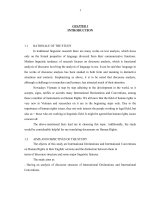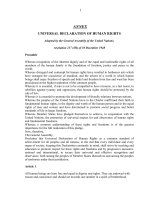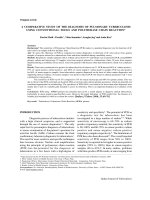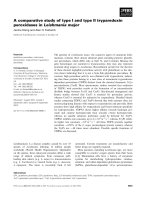Comparative study of resource use productivity and resource use efficiency of Kharif Vis-a-Vis rabi onion in Ahmednagar district of Maharashtra, India
Bạn đang xem bản rút gọn của tài liệu. Xem và tải ngay bản đầy đủ của tài liệu tại đây (175.79 KB, 5 trang )
Int.J.Curr.Microbiol.App.Sci (2018) 7(7): 2283-2287
International Journal of Current Microbiology and Applied Sciences
ISSN: 2319-7706 Volume 7 Number 07 (2018)
Journal homepage:
Original Research Article
/>
Comparative Study of Resource use Productivity and Resource use
Efficiency of Kharif Vis-a-Vis Rabi Onion in Ahmednagar
District of Maharashtra, India
M.B. More*, R.D. Shelke and K.L. Pathade
Department of Agricultural Economics, College of Agriculture, Latur, India
*Corresponding author
ABSTRACT
Keywords
MVP, MVP to price
ratio
Article Info
Accepted:
17 June 2018
Available Online:
10 July 2018
The study examined resource use efficiency of kharif vis-a-vis rabi onion
in Ahmednagar district of Maharashtra state. It was observed that, the
major resources viz., organic manure, potash, plant protection, machine
labour and hired labour used in onion cultivation showed a positive
relationship in case of rabi onion and in kharif season organic manure and
potash showed a negative relationship, It was partly due to influence of
climatic condition in kharif season.
Introduction
Onion is extremely important commercial
vegetable crop not only for internal
consumption, but also for highest foreign
exchange. It is grown in different parts of the
country mainly by small and marginal
farmers. Onion is valued for its bulbs having
characteristic odour, flavor and pungency.
Value addition in onion is done by marketing
dehydrated onions and onion flakes. Onion is
grown in three seasons kharif/ rainy i.e. June
to September, late kharif (rangda) from
September to December and rabi/winter
(pol/unhali) from December to March. India is
world’s second largest producer of onions,
likely to have 13.06 lakh hectare under crop in
2016-17 producing 122.427 lakh million
tonnes of onion with the productivity 17.32
tonnes per hectare, after China. Maharashtra
contributes nearly 31.19 per cent of the total
production and 39.56 per cent area of onion in
India with area under onion cultivation around
481.05 thousand hectare giving the production
of 6734.74 thousand MT, therefore the
productivity is 14 tonnes per hectare. Total
area under onion in Ahmednagar district was
69.98 thousand hectare in 2015-2016.
Objective
To study resource use productivity and
resource use efficiency of kharif and rabi
onion
2283
Int.J.Curr.Microbiol.App.Sci (2018) 7(7): 2283-2287
Materials and Methods
Multistage sampling design was adopted in
selection of district, tehsils and villages. In all,
60 onion growers both kharif and rabi season
growing onion crop were selected for the
study. Out of which 60 were kharif onion
growers and 60 were rabi Onion Growers,
total sample size of kharif and rabi onion
grower was 120. The resource productivity
and resource use efficiency for kharif and rabi
onion production have been analysed with
Cobb-Douglas type production function frame
work. Cobb-Douglas type of production was
fitted to the sample data separately for kharif
and rabi onion cultivation.
Results and Discussion
Resource productivity and resource use
efficiency
Partial regression coefficient with respect to
various independent variables were calculated
and are presented in Table 1&2. It was
observed from the table that partial regression
coefficient of area under kharif onion was 0.752 and rabi onion was 1.251 which was
positive and highly significant at 1 per cent
level. It inferred that when one per cent
increase in use of area under onion over its
geometric mean, it would lead to increase
production of onion by 0.467 per cent.
Similarly partial regression coefficient of
kharif and rabi onion of seed and irrigation
were -0.450, -0.004 and -0.065, -0.006
respectively which were negative and nonsignificant. Partial regression coefficient
kharif and rabi onion of machine labour was
0.090 and 0.043 respectively which was
positive and significant at 5 per cent level, and
plant protection was 0.437 and 0.470
respectively which was positive and highly
significant at 1 per cent level. Partial
regression coefficient on kharif onion of
phosphorus was 0.863 whereas, potash was
0.158 in rabi onion which were positive and
highly significant at 1 per cent level. Partial
regression coefficient on kharif and rabi onion
of hired human labour was 2.216 and 0.139
respectively which was positive and
significant at 5 per cent level in kharif and
positive and highly significant at 1 per cent
level in rabi. In kharif season bullock labour
and nitrogen were 0.009 and 0.0583
respectively which was positive and non
significant whereas, in rabi bullock labour and
nitrogen were -0.001 and -0.062 respectively
which was negative and non significant.
Partial regression coefficient of manure in
kharif season was -0.265 which was negative
whereas, positive in rabi season 0.072 and
both were statistically non-significant.
Coefficient of multiple determination kharif
and rabi onion (R2) was 0.611 and 0.99
respectively, which indicates that 61.11 and
99.00 per cent effect of all independent
variables together on onion production return
to scale was found to be 1.77 and 1.99
respectively which indicated that production
of onion found decrease in return to scale.
Resource productivity with respect to
marginal produce of area under kharif onion
was 168.92 quintals it means that when
increase in onion area by one hectare over its
geometric mean, that could be possibility to
increase in onion production by 168.92
quintals followed by that of Hired human
labour (5.199), Plant protection (4.371),
Phosphorus (0.0863), Machine labour (0.084),
Nitrogen (0.0583) and Bullock labour (0.009).
In rabi season, resource productivity with
respect to marginal produce of area under
kharif onion was 532.88 quintals it means that
when increase in onion area by one hectare
over its geometric mean, that could be
possibility to increase in onion production by
532.88 quintals followed by that of Plant
protection (6.167), Manure (1.223), Machine
labour (1.010), Potash (0.579) and Hired
human labour (0.509).
2284
Int.J.Curr.Microbiol.App.Sci (2018) 7(7): 2283-2287
Table.1 Estimates of Cobb-Douglas production function in Kharif onion production
Sr.
No.
Independent
variable
Regression
Coefficient
(bi)
Standard
error bi
(SE)
T Value
Geometric
Mean of
input (xi)
Marginal
Product
(q)
168.92
Marginal
Value
Product
(Rs.)
144643
1.
-0.752
1.276
-0.589
0.673
2.216
0.878
2.523*
-0.229
0.242
0.009
6.
Area of
onion
Hired human
labour
Family human
labour
Bullock
labour
Machine
labour
Seed
32324.39
MVP
to
Price
Ratio
4.34
64.429
5.199
4452.28
200
22.26
-0.946
58.483
-0.229
-506.874
200
-2.53
0.018
0.510
1.080
0.009
1078.73
1000
1.07
0.090
0.42
2.142*
11.800
0.084
921.493
600
1.53
-0.450
1.005
-0.447
6.062
-0.450
-9609.29
1500
-6.40
7.
Manure
-0.265
0.304
-0.779
17.111
-0.265
-2004.77
160
-12.52
8.
Nitrogen
0.0583
0.816
0.071
89.408
0.0583
84.408
13.04
6.47
9.
Phosphorus
0.863
0.144
5.993**
158.365
0.0863
705.417
38.43
18.35
10.
Potash
-0.140
0.233
-0.598
69.4155
-0.140
-261.077
28.0
-9.32
11.
Plant
protection
Irrigation
0.437
0.148
2.952**
2.179
4.371
2596.08
1077
2.41
-0.065
0.125
-0.523
3704.943
-0.065
-2.271
2.00
-1.135
2.
3.
4.
5.
12.
Price of
input
(Rs.)
Intercept (log a) -------------- 3.352
F value
-------------- 6.16
2
R
------------------- 0.611
Return to scale (∑bi) ------- 1.77
* Significant at 5 per cent level
** Significant at 1 per cent level
Note: Geometric mean of (Y) onion production was 151.18 q per farm and price was Rs.
856.25/q
2285
Int.J.Curr.Microbiol.App.Sci (2018) 7(7): 2283-2287
Table.2 Estimates of Cobb-Douglas production function in Rabi onion production
Sr. No.
Independent
variable
Regression
Coefficient
(bi)
1.251
Standard
error bi
(SE)
0.280
T Value
4.467**
Geometric
Mean of
input (xi)
0.930
Marginal
Product
(q)
532.88
Marginal
Value Product
(Rs.)
670317.10
Price of
input
(Rs.)
88892
MVP to
price
ratio
7.540
1.
Area of onion
2.
0.139
0.039
3.531**
108.024
0.509
641.210
200
3.20
-0.008
0.026
-3.301
69.282
-0.045
-57.522
200
-0.28
4.
Hired human
labour
Family human
labour
Bullock labour
-0.001
0.001
-8.905
1.0717
-0.369
-465.30
1000
-0.46
5.
Machine labour
0.043
0.021
2.047*
16.859
1.010
1270.991
600
2.11
6.
Seed
-0.004
0.076
-6.284
8.377
-0.189
-237.945
1500
-0.16
7.
Manure
0.072
0.555
0.130
23.311
1.223
1539.13
160
9.61
8.
Nitrogen
-0.062
0.247
-2.505
123.172
-0.076
-49.642
13.04
-3.80
9.
Phosphorus
-0.053
0.048
-1.093
217.751
-0.096
-121.575
38.43
-3.163
10.
Potash
0.158
0.076
2.078**
106.778
0.519
653.397
28.00
28.33
11.
Plant protection
0.470
0.152
3.092**
3.019
6.167
7757.91
1077
7.20
12.
Irrigation
-0.006
0.200
-0.032
5104.491
-0.0064
0.584
2.00
0.29
3.
Intercept (log a) --------------2.724
F value
-------------- 0.051
2
R
------------------- 0.99
Return to scale (∑bi) ------- 1.99
* Significant at 5 per cent level
** Significant at 1 per cent level
Note: Geometric mean of (Y) onion production was 396.14 q per farm and price was Rs. 1257.91/q
2286
Int.J.Curr.Microbiol.App.Sci (2018) 7(7): 2283-2287
It inferred that if area under onion production
was increased by one hectare at its geometric
mean level, it would lead to increase
production of onion with 168.92 and 532.88
quintals.
In regard to resource efficiency in kharif
season, MVP to price ratio with respect to
hired human labour was highest as 22.26
followed by area under onion potash (18.35),
nitrogen (6.47), plant protection (2.39),
machine labour (1.53) and bullock labour
(1.07) which are positive also in regard to
resource efficiency in rabi season, MVP to
price ratio with respect to potash was highest
as 28.33 followed by area under onion
manure (9.61), plant protection (7.20), hired
human labour (3.20), machine labour (2.11)
and irrigation (0.29) which are positive in
rabi season. It implied that there was scope to
increase these resources in onion production.
On the contrary, in kharif, in regard to seed,
manure, family human labour, potash,
irrigation and in rabi season family human
labour, bullock labour, seed, nitrogen and
phosphorous MVP to price ratio was negative.
It can be concluded that kharif onion farming
has MVP to price ratio of seed, manure,
family labour, potash and irrigation were
negative. It was clear that higher the MVP to
price ratio, there was greater chance to
increase these resources. When MVP to price
ratio tends to unity at that point, there would
be efficient to utilization of resource. MVP to
price ratio of area under rabi production
family human labour, bullock labour , seed,
nitrogen and phosphorus were negative. It
was clear that higher the MVP to price ratio,
there was greater chance to increase these
resource. When MVP to price ratio tends to
unity at that point, there will be
efficient utilization of resource.
References
Grema I. J. and A. G. Gashua (2014)
Economic
analysis
of
onion
production along river Komaduga area
of Yobe State, Nigeria, IOSR Journal
of Agriculture and Veterinary
Science(IOSR-JAVS). 7(10):05-11.
Ghulghule J.N., S.S. More and Thombre A.P
(2003) Resource use efficiency
of kharif and rabi onion
in
Ahmednagar district of Maharashtra
state. Agriculture Update.3(3&4) :
362-365.
Shelke R.D., Aher V.K., Bhosale M.Y. and
Gharge S.H. (2011) Resource
productivity and
resource
use
efficiency in Rabi onion production.
Internat. J. Com.& Bus. Manage. 4(2):
342-344.
Verma, A.R., A.M. Rajput, and Patidar, R.S.
(2004)
Economic
Analysis
of
production, resource use efficiency
and constraints of onion in Indore
District
of
Madhya
Pradesh,
Agricultural Marketing, 56 (4): 22-31
How to cite this article:
More, M.B., R.D. Shelke and Pathade, K.L. 2018. Comparative Study of Resource use
Productivity and Resource use Efficiency of Kharif Vis-a-Vis Rabi Onion in Ahmednagar
District of Maharashtra, India. Int.J.Curr.Microbiol.App.Sci. 7(07): 2283-2287.
doi: />
2287









